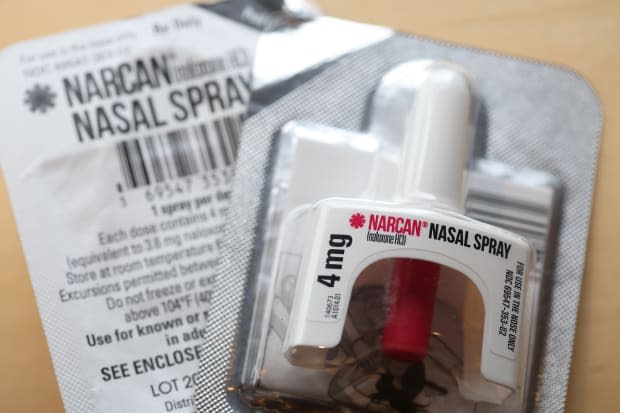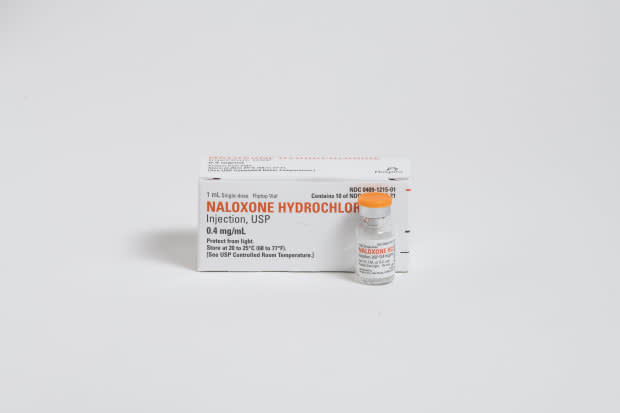The New Nasal Spray That Can Reverse a Deadly Overdose Is Now Available Over the Counter
This may save your child's life.
Here are some harrowing statistics for you: The most recent National Institutes of Health statistics research reports that more than 106,000 people in the U.S. died from drug-involved overdoses in 2021, while opioid-involved overdose deaths clocked in at 80,411—about 90% of the total. And according to the Centers for Disease Control and Prevention, there has been a significant increase in overdose deaths in minors and teens since 2019.
The FDA recently approved naloxone (commonly referred to by its brand name, Narcan) for over-the-counter (OTC) use. If you ask experts in addiction and medicine, the approval was long overdue.
"While FDA approval of OTC naloxone is good news, there are challenges to the widespread adoption of the drug," Dr. Hyong Un, MD, chief medical officer at Recovery Centers of America, tells Parade. "We must overcome barriers such as lack of awareness, cost and stigma. Additionally, although naloxone is lifesaving, follow-up treatment after use is imperative."
Here's everything parents need to know about over-the-counter Narcan (naloxone).
Related: New Fentanyl Vaccine May Prevent Overdoses and Deaths
What Is Narcan and How Does it Work?
"Narcan is the brand name for the medication naloxone hydrochloride. The FDA-approved version for selling over-the-counter is the intra-nasal version. It is an opioid antagonist, which means it binds to the same receptor which blocks the opioid from working. This blocking activity of Narcan reverses the respiratory depressing effect of the opioid and provides a life-saving benefit when a patient has overdosed on an opioid," Dr. Jonathan Watanabe, Ph.D, Associate Dean of Pharmacy Assessment and Quality at the University of California Irvine and member of the White House Opioid Committee, tells Parade.
Dr. Eric Collins, MD, addiction psychiatrist and chief medical officer at RecoveryEducation.com, explained that naloxone works for a number of drugs, including fentanyl, oxycodone and morphine.
"When a person has overdosed on opioids and has consequently stopped breathing, Narcan can help them start breathing again by effectively taking the opioid medication off the receptors," Dr. Collins says.

Related: Michael Keaton on Tackling the Opioid Epidemic in Dopesick
How Effective Is Narcan?
Narcan is popular because, thankfully, it works—usually within two to three minutes of the first dose, Dr. Watanabe says.
"There are case studies that show that additional Narcan doses may be needed depending on the amount of opioids or the strength or potency of the opioid," he advises. "Fentanyl, for example, is 100 times more potent than morphine. For this reason, the Narcan directions include that you can re-administer Narcan into the opposite nostril every two or three minutes if the patient does not respond."
Related: What Parents Should Know About Xylazine
Will Having Narcan Encourage My Child's Drug Use?
Experts agree that the pros of having naloxone on hand far outweigh any risks—and this is especially true if parents have honest and conscientious discussions with their kids about drugs.
"Any substance in the home (alcohol, cigarettes, candy, an albuterol inhaler, an Epi-pen) presents an opportunity to have an age-appropriate conversation with our children and young adults about substances and the risks of their use," Dr. Matthew Ruble, MD, Chief Medical Officer of Discovery Behavioral Health, tells Parade.
"We have so much evidence that age-appropriate discussions with kids lead to better outcomes. We know that discussions about sexual activity don't lead to sexual activity. We also know that discussions about suicide do not lead to or suggest suicide. Discussing how to save a person's life with Narcan should follow these same trends if discussed appropriately. Risk compensation, the balancing of the risks with the benefits of this education is very clearly in favor of education. People are much safer if they wear a seatbelt. The benefits of the seatbelt so greatly outweigh the risks."
"Naloxone has been likened to epinephrine auto-injectors (EpiPens), helping safeguard at-risk individuals from opioid overdose or anaphylaxis, respectively," Dr. Christina Johns, MD, pediatric emergency doctor & Senior Medical Advisor at PM Pediatric Care, concurs. "Just like having an EpiPen at home does not encourage kids with peanut allergies to dive into a pool of Jiffy, having naloxone handy will not necessarily lead to children experimenting with opioid drugs."

"About 2.7 million people in the United States report suffering from OUD, which we know is an underestimate," Dr. Watanabe says. "On average, we’re losing an American to an overdose every five minutes. So I would say that every person that is concerned they may at one point be a bystander should at the very least know where Narcan is present."
Related: The Best Movies About Addiction, Alcoholism and Recovery
How To Use Narcan
Dr. Johns says that because there are essentially no known negative effects of Narcan and naloxone, having it on hand is a good idea—and there are resources if you have questions on how to use or administer it.
"If you suspect your child may be misusing opioid drugs, don’t go it alone. Get support," she advises. "Check in with your pediatrician and local pharmacy for guidance on acquiring and using naloxone." You can also check to see if there are any local classes on using naloxone.
That said, the first step should be to shake the patient's shoulders and call their name. If they're unresponsive, check their breathing: Is it slow, uneven or stopped? Are they snoring, gasping or gurgling? Are their lips or fingernails purple or blue? If so, administer naloxone.
To administer naloxone:
Use one spray in one nostril to start.
Remove the nozzle from the person's nostril after spraying.
After administering naloxone, position the patient on their side with their hands under their head and their upper leg bent forward. This will prevent them from rolling onto their stomach, which can be deadly for an overdosing person.
If the overdosing individual doesn't respond within two to three minutes, you can spray another new dose of naloxone into the patient's other nostril.
You can repeat, alternating nostrils, until the patient responds and breathes normally.
It's also incredibly important to get the patient emergency medical attention after the patient's first dose, even if they wake up and are responsive.
You can see a video demonstrating how to use Narcan below:
Related: What Does It Mean to Be Sober Curious?
What Are Narcan Side Effects?
Narcan can cause sudden and severe withdrawal symptoms in patients who've used opioids regularly. These can include aggressive behavior, body aches, diarrhea, fever, goosebumps, increased blood pressure, increased heart rate, irritability, nausea, nervousness, restlessness, runny nose, shivering, sneezing, stomach cramps, sweating, trembling, vomiting, weakness and yawning.
How To Talk to Kids About Narcan
As with a lot of other things, the guidance on drug discussions with children varies by the child and their age, but it's an important conversation to have. Why? Because in 2019 alone, 1 in 7 high school seniors admitted to misusing opioids during their life already.
"Talking to children about naloxone should be tailored to their developmental level—the younger the child, the simpler the answer should be," Dr. Johns says. "It’s always a good idea to ask questions to understand what they know about the topic first; then you’ll have a better idea of how to address the subject."
One key: Don't act like an encyclopedia if you're not. "Be comfortable saying 'I don’t know' if you don’t know the answer to one of their questions," Dr. Johns notes, "and agree to find out the answer together."
Clinical psychologist and Hope for Depression Research Foundation adviser Dr. Ernesto Lira de la Rosa, Ph.D., says that these conversations should be ongoing as children grow up.
"For example, young children may benefit from a conversation around the importance of the safe use of medications and that medications should only be used as prescribed. As children get older, you may talk to them about the dangers of taking opioids or other drugs," Dr. de La Rosa explains. "You may also talk with them about what to do in situations when they feel pressured by peers to use drugs, including prescription medications."
Dr. Ruble also has another key tip: Encourage your teen to bring Narcan to parties and tell other parents you had the talk—because only one opioid use can be deadly.
Next, what is the BORG binge drinking trend on TikTok? Here's what parents should know.
